Cisco Certification Exam Prep Materials
Cisco CCNA Exam Prep Material Download
Cisco CCT Exam Prep Material Download
- Cisco 010-151 Dumps PDF
- Cisco 100-490 Dumps PDF
- Cisco 100-890 Dumps PDF
- Tips: Beginning February 10, the CCT Certification 500-150 FLDTEC v1.0 exam will replace the 100-490, 010-151, and 100-890 exams.
Cisco CyberOps Exam Prep Material Download
Cisco DevNet Exam Prep Material Download
Cisco CCNP Exam Prep Material Download
- Cisco 300-410 Dumps PDF
- Cisco 300-415 Dumps PDF
- Cisco 300-420 Dumps PDF
- Cisco 300-425 Dumps PDF
- Cisco 300-430 Dumps PDF
- Cisco 300-435 Dumps PDF
- Cisco 300-440 Dumps PDF
- Cisco 300-510 Dumps PDF
- Cisco 300-515 Dumps PDF
- Cisco 300-535 Dumps PDF
- Cisco 300-610 Dumps PDF
- Cisco 300-615 Dumps PDF
- Cisco 300-620 Dumps PDF
- Cisco 300-630 Dumps PDF
- Cisco 300-635 Dumps PDF
- Cisco 300-710 Dumps PDF
- Cisco 300-715 Dumps PDF
- Cisco 300-720 Dumps PDF
- Cisco 300-725 Dumps PDF
- Cisco 300-730 Dumps PDF
- Cisco 300-735 Dumps PDF
- Cisco 300-810 Dumps PDF
- Cisco 300-815 Dumps PDF
- Cisco 300-820 Dumps PDF
- Cisco 300-835 Dumps PDF
Cisco CCIE Exam Prep Material Download
- Cisco 350-401 Dumps PDF
- Cisco 350-501 Dumps PDF
- Cisco 350-601 Dumps PDF
- Cisco 350-701 Dumps PDF
- Cisco 350-801 Dumps PDF
Cisco CCDE Exam Prep Material Download
Cisco Other Exam Prep Material Download
- Cisco 500-052 Dumps PDF
- Cisco 500-210 Dumps PDF
- Cisco 500-220 Dumps PDF
- Cisco 500-420 Dumps PDF
- Cisco 500-442 Dumps PDF
- Cisco 500-444 Dumps PDF
- Cisco 500-470 Dumps PDF
- Cisco 500-490 Dumps PDF
- Cisco 500-560 Dumps PDF
- Cisco 500-710 Dumps PDF
- Cisco 700-150 Dumps PDF
- Cisco 700-750 Dumps PDF
- Cisco 700-760 Dumps PDF
- Cisco 700-765 Dumps PDF
- Cisco 700-805 Dumps PDF
- Cisco 700-821 Dumps PDF
- Cisco 700-826 Dumps PDF
- Cisco 700-846 Dumps PDF
- Cisco 700-905 Dumps PDF
- Cisco 820-605 Dumps PDF
Fortinet Exam Dumps
fortinet nse4_fgt-6.4 dumps (pdf + vce)
fortinet nse4_fgt-6.2 dumps (pdf + vce)
fortinet nse5_faz-6.4 dumps (pdf + vce)
fortinet nse5_faz-6.2 dumps (pdf + vce)
fortinet nse5_fct-6.2 dumps (pdf + vce)
fortinet nse5_fmg-6.4 dumps (pdf + vce)
fortinet nse5_fmg-6.2 dumps (pdf + vce)
fortinet nse6_fml-6.2 dumps (pdf + vce)
fortinet nse6_fnc-8.5 dumps (pdf + vce)
fortinet nse7_efw-6.4 dumps (pdf + vce)
fortinet nse7_efw-6.2 dumps (pdf + vce)
fortinet nse7_sac-6.2 dumps (pdf + vce)
fortinet nse7_sdw-6.4 dumps (pdf + vce)
fortinet nse8_811 dumps (pdf + vce)
Valid Microsoft AZ-104 dumps questions shared by Pass4itsure for helping to pass the Microsoft AZ-104 exam! Get the newest Pass4itsure AZ-104 exam dumps with VCE and PDF here: https://www.pass4itsure.com/az-104.html (419 Q&As Dumps).
Suitable for AZ-104 complete Microsoft learning pathway
The content is rich and diverse, and learning will not become boring. You can learn in multiple ways through the Microsoft AZ-104 exam.
- Download
- Watch the video
- Answer practice questions, the actual test
Microsoft Azure Administrator
Free Microsoft AZ-104 dumps download
[PDF] Free Microsoft AZ-104 dumps pdf download https://drive.google.com/file/d/1PC2qT8gU1VjZW1v8jzBwfh-7EQfZyv80/view?usp=sharing
Pass4itsure offers the latest Microsoft AZ-104 practice test free of charge 1-13
QUESTION 1
You have an Azure virtual machine named VM1.
The network interface for VM1 is configured as shown in the exhibit. (Click the Exhibit tab.)
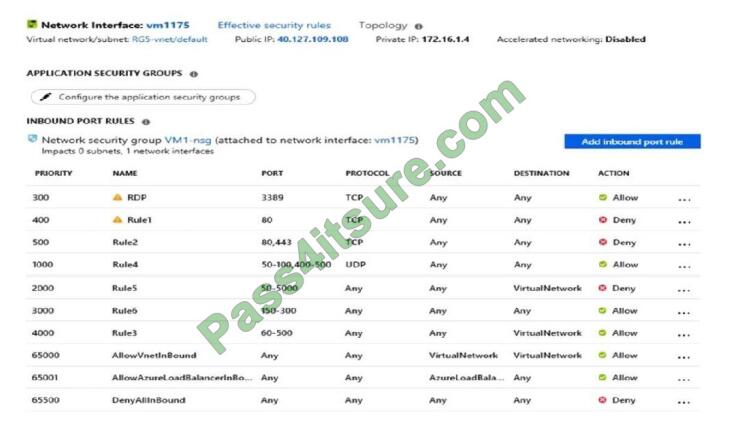
You deploy a web server on VM1, and then create a secure website that is accessible by using the HTTPS protocol.
VM1 is used as a web server only.
You need to ensure that users can connect to the website from the internet. What should you do?
A. Create a new inbound rule that allows TCP protocol 443 and configure the protocol to have a priority of 501.
B. For Rule5, change the Action to Allow and change the priority to 401.
C. Delete Rule1.
D. Modify the protocol of Rule4.
Correct Answer: B
Rule 2 is blocking HTTPS access (port 443) and has a priority of 500. Changing Rule 5 (ports 50-5000) and giving it a
lower priority number will allow access on port 443. Note: Rules are processed in priority order, with lower numbers
processed before higher numbers, because lower numbers have higher priority. Once traffic matches a rule, processing
stops.
References: https://docs.microsoft.com/en-us/azure/virtual-network/security-overview
QUESTION 2
Note: This question is part of a series of questions that present the same scenario. Each question in the series contains
a unique solution that might meet the stated goals. Some question sets might have more than one correct solution,
while
others might not have a correct solution. After you answer a question in this section, you will NOT be able to return to it.
As a result, these questions will not appear in the review screen. You have an Azure Active Directory (Azure AD) tenant
named Adatum and an Azure subscription named Subscription1. Adam contains a group named Developers.
Subscription1 contains a resource group named Dev.
You need to provide the Developers group with the ability to create Azure logic apps in the Dev resource group.
Solution: On Dev, you assign the Logic App Contributor role to the Developers group.
Does this meet the goal?
A. Yes
B. No
Correct Answer: A
The Logic App Contributor role lets you manage the logic app, but not access them. It provides access to view, edit, and
update a logic app.
References:
https://docs.microsoft.com/en-us/azure/role-based-access-control/built-in-roles
https://docs.microsoft.com/en-us/azure/logic-apps/logic-apps-securing-a-logic-app
QUESTION 3
DRAG DROP
You are configuring serverless computing in Azure.
You need to receive an email message whenever a resource is created in or deleted from a resource group.
Which three actions should you perform in sequence? To answer, move the appropriate actions from the list of actions
to the answer area and arrange them in the correct order.
Select and Place:
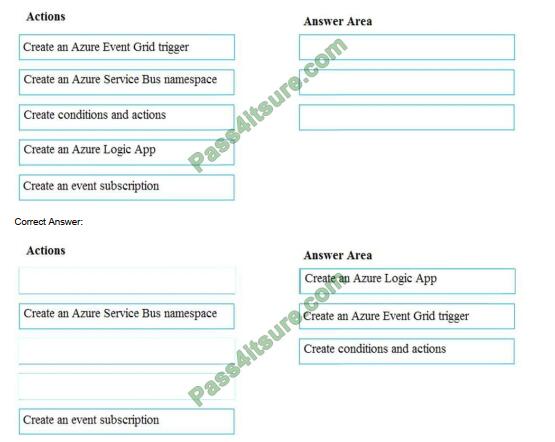
References: https://docs.microsoft.com/en-us/azure/event-grid/monitor-virtual-machine-changes-event-grid-logic-app
Action 1: Create an Azure Logic App
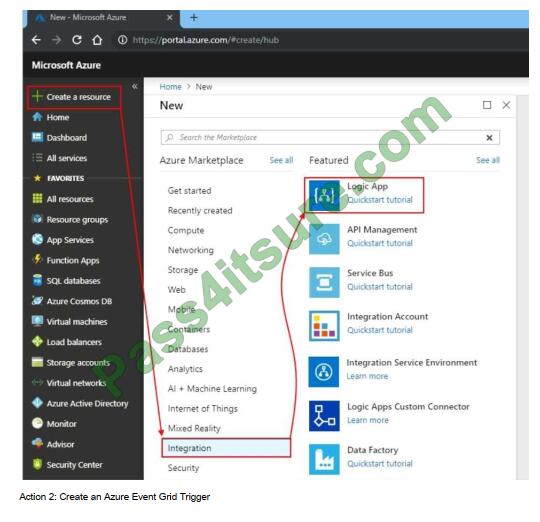

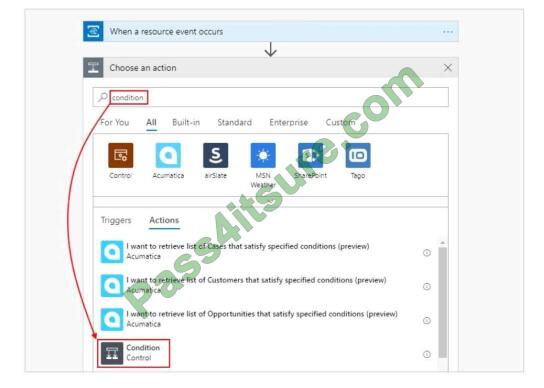
References: https://docs.microsoft.com/en-us/azure/event-grid/monitor-virtual-machine-changes-event-grid-logic-app
QUESTION 4
You have an Azure resource manager template that will be used to deploy 10 Azure Web Apps. You have to ensure to
deploy the pre-requisites before the deployment of the template. You have to minimize the costs associated with the
implementation. Which of the following would you deploy as pre-requisites?
A. An Azure Load Balancer
B. An Application Gateway
C. 10 Azure App Service Plans
D. One App Service Plan
Correct Answer: D
In-App Service (Web Apps, API Apps, or Mobile Apps), an app always runs in an App Service plan. An App Service plan
defines a set of computing resources for a web app to run.
One App Service Plan: Correct Choice
For an Azure Web App, you need to have an Azure App Service Plan in place. You can associate multiple Azure Web
Apps with the same App Service Plan. Hence to save on costs, you can just have one Azure App Service Plan in place.
An Azure Load Balancer: Incorrect Choice
An Azure load balancer is a Layer-4 (TCP, UDP) load balancer that provides high availability by distributing incoming
traffic among healthy VMs. A load balancer health probe monitors a given port on each VM and only distributes traffic to
an
operational VM An Application Gateway: Incorrect Choice
Azure Application Gateway is a web traffic load balancer that enables you to manage traffic to your web applications.
Traditional load balancers operate at the transport layer (OSI layer 4 – TCP and UDP) and route traffic based on source
IP
address and port, to a destination IP address and port.
10 Azure App Service Plans: Incorrect Choice
For an Azure Web App, you need to have an Azure App Service Plan in place. You can associate multiple Azure Web
Apps with the same App Service Plan. Hence to save on costs, you can just have one Azure App Service Plan in place.
So
there is no need for 10 App Service Plans.
Reference:
https://docs.microsoft.com/en-us/azure/app-service/overview-hosting-plans https://docs.microsoft.com/enus/azure/virtual-machines/windows/tutorial-load-balancer https://docs.microsoft.com/en-us/azure/applicationgateway/overview
QUESTION 5
You need to use Azure Automation State Configuration to manage the ongoing consistency of a virtual machine
configurations.
Which five actions should you perform in sequence? To answer, move the appropriate action from the list of actions to
the answer area and arrange them in the correct order. NOTE: More than one order of answer choices is correct. You
will
receive credit for any of the correct orders you select.
Select and Place:
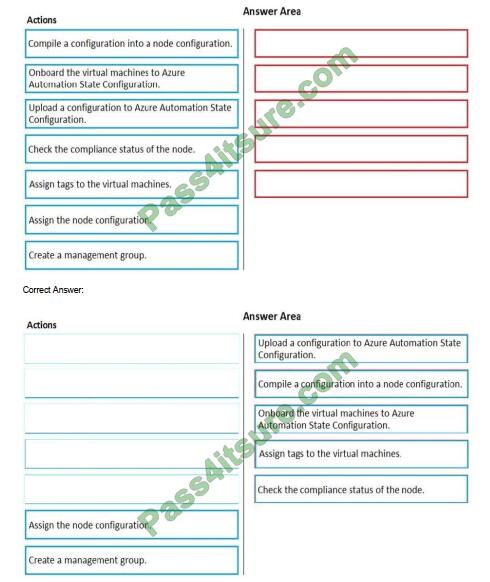
Step 1: Upload a configuration to the Azure Automation State Configuration. Import the configuration into the Automation
account. Step 2: Compile a configuration into a node configuration. A DSC configuration defining that state must be
compiled into one or more node configurations (MOF document), and placed on the Automation DSC Pull Server. Step
3: Onboard the virtual machines to Azure Automation State Configuration. Onboard the Azure VM for management with
Azure Automation State Configuration Step 4: Assign the node configuration Step 5: Check the compliance status of the
node Each time Azure Automation State Configuration performs a consistency check on a managed node, the node
sends a status report back to the pull server. You can view these reports on the
page for that node.
On the blade for an individual report, you can see the following status information for the corresponding consistency
check:
The report states – whether the node is “Compliant”, the configuration “Failed”, or the node is “Not Compliant”
References:
https://docs.microsoft.com/en-us/azure/automation/automation-dsc-getting-started
QUESTION 6
Note: This question is part of a series of questions that present the same scenario. Each question in the series contains
a unique solution that might meet the stated goals. Some question sets might have more than one correct solution,
while
others might not have a correct solution. After you answer a question in this section, you will NOT be able to return to it.
As a result, these questions will not appear in the review screen.
You have an Azure subscription that contains 10 virtual networks. The virtual networks are hosted in separate resource
groups.
Another administrator plans to create several network security groups (NSGs) in the subscription. You need to ensure
that when an NSG is created, it automatically blocks TCP port 8080 between the virtual networks.
Solution: You create a resource lock, and then you assign the lock to the subscription.
Does this meet the goal?
A. Yes
B. No
Correct Answer: B
How can I freeze or lock my production/critical Azure resources from accidental deletion? There is a way to do this with
both ASM and ARM resources using Azure resource lock.
References:
https://blogs.msdn.microsoft.com/azureedu/2016/04/27/using-azure-resource-manager-policy-and-azure-lock-to-controlyour-azure-resources/
QUESTION 7
Note: This question is part of a series of questions that present the same scenario. Each question in the series contains a unique solution that might meet the stated goals. Some question sets might have more than one correct solution,
while
others might not have a correct solution. After you answer a question in this section, you will NOT be able to return to it.
As a result, these questions will not appear in the review screen.
You deploy an Azure Kubernetes Service (AKS) cluster named AKS1.
You need to deploy a YAML file to AKS1.
Solution: From Azure Cloud Shell, you run az aks.
Does this meet the goal?
A. Yes
B. No
Correct Answer: A
Installing Azure CLI doesn\\’t mean that Azure Kubernates client is installed. So before running kubectl client command,
you have install kubectl, the Kubernetes command-line client. First need to run az aks install-cli to install Kubernetes
CLI,
which is kubectl Reference:
https://docs.microsoft.com/en-us/cli/azure/aks?view=azure-cli-latest
QUESTION 8
You have an Azure subscription that includes data in following locations:
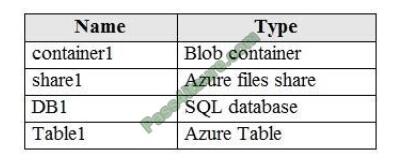
You plan to export data by using Azure import/export job named Export1. You need to identify the data that can be
exported by using Export1. Which data should you identify?
A. DB1
B. Table1
C. container1
D. Share1
Correct Answer: C
Azure Import/Export service is used to securely import large amounts of data to Azure Blob storage. Only the Blob
service is supported with the Export job feature
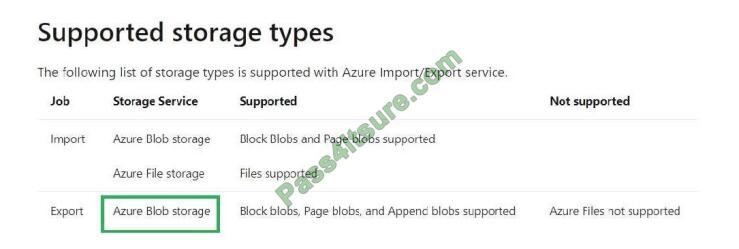
References: https://docs.microsoft.com/en-us/azure/storage/common/storage-import-export-requirements
QUESTION 9
You have an Azure App Service plan named AdatumASP1 that uses the P2v2 pricing tier. AdatumASP1 hosts Ml Azure
web app named adatumwebapp1. You need to delegate the management of adatumwebapp1 to a group named Devs.
Devs must be able to perform the following tasks:
1.
Add deployment slots.
2.
View the configuration of AdatumASP1.
3.
Modify the role assignment for adatumwebapp1. Which role should you assign to the Devs group?
A. Owner
B. Contributor
C. Web Plan Contributor
D. Website Contributor
Correct Answer: A
Owner : Correct Choice
The Owner role lets you manage everything, including access to resources.
Contributor : Incorrect Choice
With contributor role you can Add deployment slots and View the configuration of App service plan but you can\\’t Modify
the role assignment. For this you need User Access Administrator or Owner role. So this is incorrect.
Web Plan Contributor : Incorrect Choice
The Web Plan Contributor role lets you manage the web plans for websites, but not access to them.
So this option is incorrect.
Website Contributor : Incorrect Choice
The Website Contributor role lets you manage websites (not web plans), but not access to them. So this is incorrect
option.
Note:
As per least privilege principle it is not advisable to provide owner role to any group, rather you should create custom
RBAC role with custom policy and use that role for this operation. However as this option is not available here so only
option
to go with owner role.
References:
https://docs.microsoft.com/en-us/azure/role-based-access-control/role-assignments-portal
https://docs.microsoft.com/en-us/azure/role-based-access-control/built-in-roles
QUESTION 10
HOTSPOT
You have an Azure Active Directory (Azure AD) tenant. You need to create a conditional access policy that requires all
users to use multi-factor authentication when they access the Azure portal.
Which three settings should you configure? To answer, select the appropriate settings in the answer area.
Hot Area:
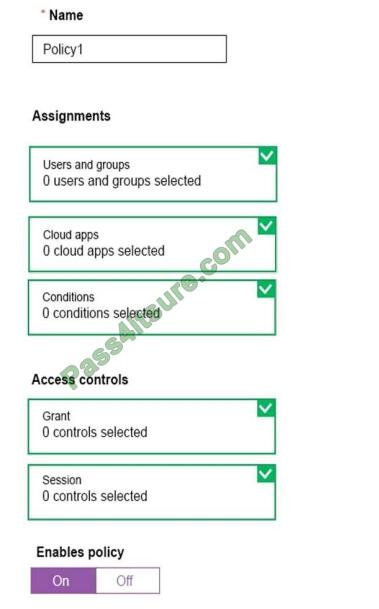
Correct Answer
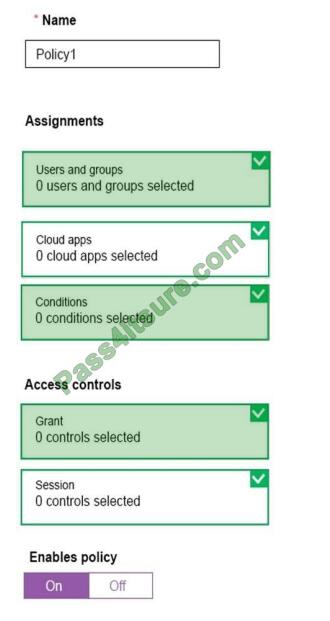
Box 1: Assignments, Users and Groups
When you configure the sign-in risk policy, you need to set:
The users and groups the policy applies to: Select Individuals and Groups
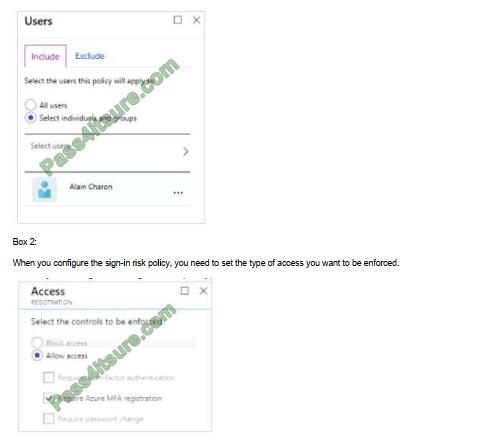
Box 3:
When you configure the sign-in risk policy, you need to set:
The type of access you want to be enforced when your sign-in risk level has been met:
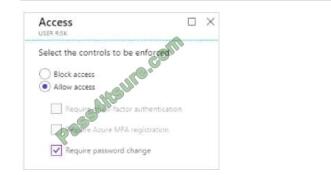
References: https://docs.microsoft.com/en-us/azure/active-directory/identity-protection/howto-user-risk-policy
QUESTION 11
Note: This question is part of a series of questions that present the same scenario. Each question in the series contains
a unique solution that might meet the stated goals. Some question sets might have more than one correct solution,
while
others might not have a correct solution. After you answer a question in this section, you will NOT be able to return to it.
As a result, these questions will not appear in the review screen. You have an Azure virtual machine named VM1. VM1
was deployed by using a custom Azure Resource Manager template named ARM1.json.
You receive a notification that VM1 will be affected by maintenance.
You need to move VM1 to a different host immediately.
Solution: Solution: From the Overview blade, you move the virtual machine to a different subscription.
Does this meet the goal?
A. Yes
B. No
Correct Answer: B
You would need to Redeploy the VM.
References:
https://docs.microsoft.com/en-us/azure/virtual-machines/windows/redeploy-to-new-node
QUESTION 12
HOTSPOT
You have an Azure Storage account named storage1 that uses Azure Blob storage and Azure File storage.
You need to use AzCopy to copy data to the blob storage and file storage in storage1.
Which authentication method should you use for each type of storage? To answer, select the appropriate options in the
answer area.
NOTE: Each correct selection is worth one point.
Hot Area:
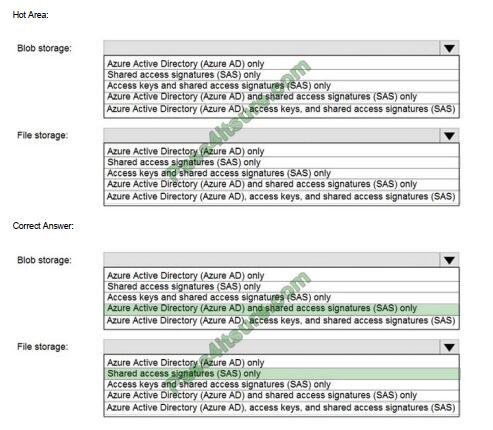
You can provide authorization credentials by using Azure Active Directory (AD), or by using a Shared Access Signature
(SAS) token.
Box 1:
Both Azure Active Directory (AD) and Shared Access Signature (SAS) token are supported for Blob storage.
Box 2:
Only Shared Access Signature (SAS) token is supported for File storage.
Reference:
https://docs.microsoft.com/en-us/azure/storage/common/storage-use-azcopy-v10
QUESTION 13
You have a hybrid infrastructure that contains an Azure Active Directory (Azure AD) tenant named
contoso.onmicrosoft.com. The tenant contains the users shown in the following table.

You plan to share a cloud resource to the All Users group. You need to ensure that User1, User2, User3, and User4 can
connect successfully to the cloud resource.
What should you do first?
A. Create a user account of the member type for User4.
B. Create a user account of the member type for User3.
C. Modify the Directory-wide Groups settings.
D. Modify the External collaboration settings.
Correct Answer: C
Ensure that “Enable an \\’All Users\\’ group in the directory” policy is set to “Yes” in your Azure Active Directory (AD)
settings in order to enable the “All Users” group for centralized access administration. This group represents the entire
collection of Active Directory users, including guests and external users, that you can use to make the access
permissions easier to manage within your directory.
Incorrect Answers:
A, B: User3 and User4 are guests already.
Note: By default, all users and guests in your directory can invite guests even if they\\’re not assigned to an admin role.
External collaboration settings let you turn guest invitations on or off for different types of users in your organization.
You
can also delegate invitations to individual users by assigning roles that allow them to invite guests.
References: https://www.cloudconformity.com/knowledge-base/azure/ActiveDirectory/enable-all-users-group.html
What customers say about Pass4itsure
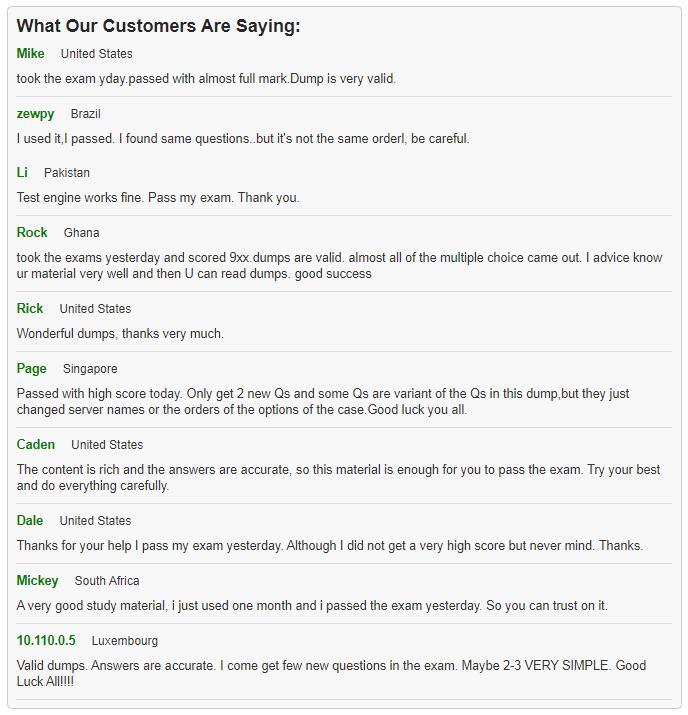
Latest Microsoft dumps discount code “Microsoft” – Pass4itsure

Summarize:
[Q1-Q13] Free Microsoft AZ-104 dumps pdf download https://drive.google.com/file/d/1PC2qT8gU1VjZW1v8jzBwfh-7EQfZyv80/view?usp=sharing
Share all the resources: Latest Microsoft AZ-104 practice questions, latest Microsoft AZ-104 pdf dumps, Microsoft AZ-104 exam video learning. Latest updated Microsoft AZ-104 dumps https://www.pass4itsure.com/az-104.html Study hard and practices a lot. This will help you prepare for the AZ-104 exam. Good luck!
Written by Ralph K. Merritt
We are here to help you study for Cisco certification exams. We know that the Cisco series (CCNP, CCDE, CCIE, CCNA, DevNet, Special and other certification exams are becoming more and more popular, and many people need them. In this era full of challenges and opportunities, we are committed to providing candidates with the most comprehensive and comprehensive Accurate exam preparation resources help them successfully pass the exam and realize their career dreams. The Exampass blog we established is based on the Pass4itsure Cisco exam dump platform and is dedicated to collecting the latest exam resources and conducting detailed classification. We know that the most troublesome thing for candidates during the preparation process is often the massive amount of learning materials and information screening. Therefore, we have prepared the most valuable preparation materials for candidates to help them prepare more efficiently. With our rich experience and deep accumulation in Cisco certification, we provide you with the latest PDF information and the latest exam questions. These materials not only include the key points and difficulties of the exam, but are also equipped with detailed analysis and question-answering techniques, allowing candidates to deeply understand the exam content and master how to answer questions. Our ultimate goal is to help you study for various Cisco certification exams, so that you can avoid detours in the preparation process and get twice the result with half the effort. We believe that through our efforts and professional guidance, you will be able to easily cope with exam challenges, achieve excellent results, and achieve both personal and professional improvement. In your future career, you will be more competitive and have broader development space because of your Cisco certification.
Categories
2025 Microsoft Top 20 Certification Materials
- Microsoft Azure Administrator –> az-104 dumps
- Microsoft Azure Fundamentals –> az-900 dumps
- Data Engineering on Microsoft Azure –> dp-203 dumps
- Developing Solutions for Microsoft Azure –> az-204 dumps
- Microsoft Power Platform Developer –> pl-400 dumps
- Designing and Implementing a Microsoft Azure AI Solution –> ai-102 dumps
- Microsoft Power BI Data Analyst –> pl-300 dumps
- Designing and Implementing Microsoft DevOps Solutions –> az-400 dumps
- Microsoft Azure Security Technologies –> az-500 dumps
- Microsoft Cybersecurity Architect –> sc-100 dumps
- Microsoft Dynamics 365 Fundamentals Customer Engagement Apps (CRM) –> mb-910 dumps
- Microsoft Dynamics 365 Fundamentals Finance and Operations Apps (ERP) –> mb-920 dumps
- Microsoft Azure Data Fundamentals –> dp-900 dumps
- Microsoft 365 Fundamentals –> ms-900 dumps
- Microsoft Security Compliance and Identity Fundamentals –> sc-900 dumps
- Microsoft Azure AI Fundamentals –> ai-900 dumps
- Microsoft Dynamics 365: Finance and Operations Apps Solution Architect –> mb-700 dumps
- Microsoft 365 Certified: Enterprise Administrator Expert –> ms-102 dumps
- Microsoft 365 Certified: Collaboration Communications Systems Engineer Associate –> ms-721 dumps
- Endpoint Administrator Associate –> md-102 dumps

